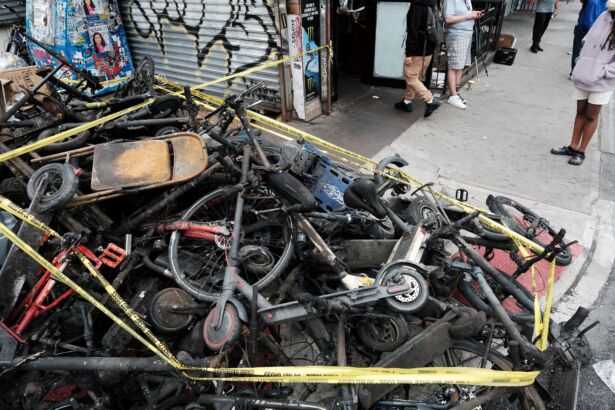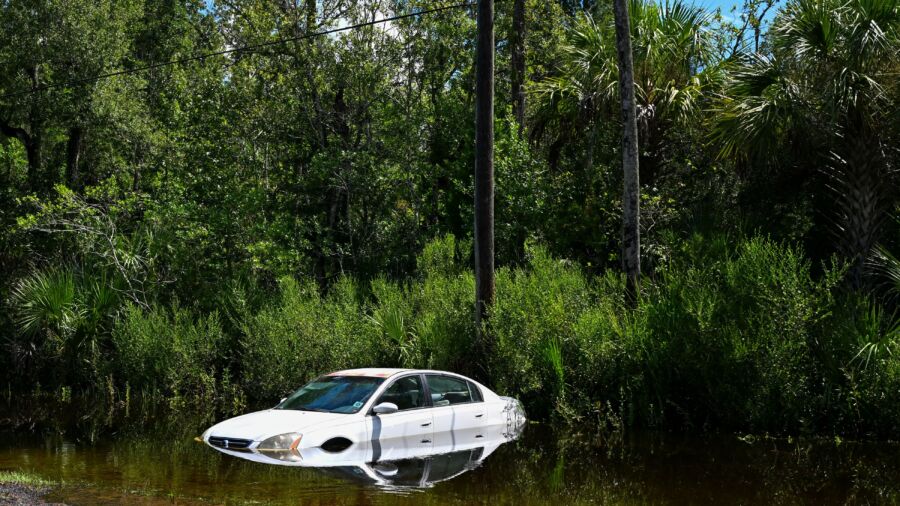Hurricane Idalia and subsequent floods have created an electric vehicle fire risk in Florida as batteries exposed to saltwater become susceptible to combustion, based on statements from one of the fire departments in the state.
“WARNING. If you own a hybrid or electric vehicle that has come into contact with saltwater due to recent flooding within the last 24 hours, it is crucial to relocate the vehicle from your garage without delay. Saltwater exposure can trigger combustion in lithium-ion batteries. If possible, transfer your vehicle to higher ground,” Palm Harbor Fire Rescue (PHFR), Florida, said in an Aug. 30 Facebook post.
“This includes golf carts and electric scooters. Don’t drive these through water. PHFR crews have seen numerous residents out in golf carts and children on scooters riding through water.”
The issue with saltwater is that even if the water dries off, the residue can remain, potentially triggering electrical connections within the EV battery, which eventually sparks into a fire. In the post, PHFR pointed to two Tesla EVs in Dunedin that had caught fire.
EV fires in the wake of the storm are not an unforeseen occurrence. Prior to the storm surge, Florida Chief Financial Officer (CFO) and State Fire Marshal Jimmy Patronis warned citizens that saltwater from the storms can trigger fires in electric vehicles “which cannot be easily suppressed.”
“The best fire teams can do is keep water on the battery until the fuel burns out,” he said. “If you’re evacuating and leaving an EV, or other lithium-ion powered devices like scooters or golf carts in your garage, you’re creating a real fire threat for your home, your communities, and first responders.”
A critical thing to note here is that lithium-ion batteries need not catch fire immediately after being exposed to water. Instead, the fires can break out later.
“And it can take from days to weeks,” Patrick Olsen, spokesperson for Carfax, which sells new and used vehicles, told CBS.
He pointed out that many EV owners are not aware of the risks that floods pose to their vehicles. “I have heard EV owners say, ‘I don’t have an engine that can be flooded so I can drive in deep water.’ That’s not the case.”
In an interview with the outlet, PHFFR training chief Jason Haynes said that while fire crews were towing vehicles, a submerged Tesla abruptly went up in flames.
EV Battery Fires, Tesla Guidance
Lithium-ion batteries contain groups of cells that are packed inside a compartment. It also contains a flammable liquid electrolyte. EVs can contain 1,000 times more cells compared to e-bikes.
When water enters an EV battery, a short circuit can get triggered, causing the cell to discharge energy and heat. This can result in a “thermal runaway,” which refers to a situation in which the heat spreads from one cell to another—leading to an outburst.

“That heat can get transferred to the next cell and it can become a chain reaction,” Thomas Barth, chief of the special investigations branch of highway safety at the National Transportation Safety Board, said to USA Today.
“If you have a damaged lithium-ion battery and it has energy which remains in the battery pack, we call that stranded energy … If you initiate a thermal runaway or venting of the flammable gas, the battery can ignite.”
In some cases, even if the water drains out of the battery without causing an incident, contaminants and leftover substances like salt can be the cause of short-circuiting.
Tesla has issued guidance for owners on how to handle submerged EVs. It asks owners to tow the vehicle or move it at least 50 feet away from structures and combustible materials.
The company warned people against attempting to operate a submerged vehicle unless it has been inspected by an authorized shop.
“If you notice fire, smoke, audible popping/hissing, or heating coming from your vehicle, step away and immediately contact your local first responders.”
EV Fire Risk
The problem of EVs catching fire was a major issue in the aftermath of Hurricane Ian in 2022. In a letter to the National Highway Traffic Safety Administration (NHTSA) following the hurricane, Florida CFO Mr. Patronis called the potential of EV fires a “ticking time bomb on our hands.”

“I joined North Collier Fire Rescue to assess response activities related to Hurricane Ian and saw with my own eyes an EV continuously ignite, and continually reignite, as fire teams doused the vehicle with tens of thousands of gallons of water,” he wrote.
“I was informed by the fire department that the vehicle, once again reignited when it was loaded onto the tow truck.”
According to the State Fire Marshal’s Office, 21 fires have been associated with electric vehicles following Hurricane Ian.
Even without being submerged in water, EV fires are now a major concern in several places. In New York, there were 220 fires last year due to electric batteries in e-micromobility devices, up from just 44 in 2020.
“These fires are particularly severe and difficult to extinguish, spreading quickly, and producing noxious fumes,” officials said in a news release.
In a report on safety recommendations, the Fire Department of the City of New York (FDNY) warned that “lithium-Ion batteries are known to unexpectedly reignite (without warning) minutes, hours, and even days after all visible fire has been put out.”
The batteries “can enter an uncontrollable, self-heating state. This can result in the release of gas, cause fire, and possible explosion.”
From The Epoch Times

